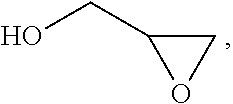Process for the purification of polyol PFPE derivative
a technology of pfpe and derivative, applied in the direction of natural resin process, chemistry apparatus and process, etc., can solve the problems of unable to possess the targeted anchoring diol function as end-chain, the final material cannot meet the expected stoichiometry, and the material is more difficult to separate based on the volatility of the respective variable, so as to achieve high selectivity
- Summary
- Abstract
- Description
- Claims
- Application Information
AI Technical Summary
Benefits of technology
Problems solved by technology
Method used
Image
Examples
example 2
Tetraol 2000 Broad MWD+Diac 2000
Analysis of Raw Mixture (M2)
[0148]A mixture (M2) was submitted to NMR analysis as such and after derivatization with trifluoroacetic anhydride, as detailed in example 1.
[0149]The analysis yielded the following composition for mixture (M2):[0150]12% end groups of formula —CF2CH2OH[0151]12% end groups of formula —CF2CH2O—CH2CH(OH)—CH2O—CH2—CH(OH)—CH2OH (bis-adduct);[0152]76% end groups of formula —CF2CH2O—CH2CH(OH)—CH2OH.
[0153]Its other relevant molecular parameters, as determined by GPC analysis are: average molecular weight=2000, Polydispersity 1.45.
[0154]Step 2.1: Protection of Vicinal Hydroxyl Groups
[0155]Same procedure as detailed in step 1.1 (ex. 1) was followed, but using 600 g (0.30 moles) of mixture (M2), 220 g (280 ml, 3.8 moles) of acetone, 280 ml of petroleum ether and 0.24 g of sulphuric acid, as well as 1.2 g of sodium acetate. 590 g of protected ketal mixture were isolated and characterized.
[0156]Step 2.2: Esterification with a PFPE Diaci...
example 3
Tetraol 1000 Narrow MWD+Diac 2000
[0168]Analysis of Raw Mixture (M3)
[0169]A mixture (M3) was submitted to NMR analysis as such and after derivatization with trifluoroacetic anhydride, as detailed in example 1. The analysis yielded the following composition for mixture (M3):[0170]10% end groups of formula —CF2CH2OH[0171]14% end groups of formula —CF2CH2O—H2CH(OH)—CH2O—CH2—CH(OH)—CH2OH (bis-adduct);[0172]76% end groups of formula —CF2CH2O—CH2CH(OH)—CH2OH.
[0173]Its other relevant molecular parameters, as determined by GPC analysis are: average molecular weight=1000, Polydispersity 1.08.
[0174]Step 3.1: Protection of Vicinal Hydroxyl Groups
[0175]Same procedure as detailed in step 1.1 (ex. 1) was followed, but using 300 g (0.30 moles) of mixture (M3), 220 g (280 ml, 3.8 moles) of acetone, 280 ml of petroleum ether and 0.24 g of sulphuric acid, as well as 1.2 g of sodium acetate. 320 g of protected ketal mixture were isolated and characterized.
[0176]Step 3.2: Esterification with a PFPE Diac...
example 4
Tetraol 2000 Narrow MWD+Dodecandioic Acid Acyl Chloride
[0188]Analysis of Raw Mixture (M1)
[0189]Same mixture (M1) of example 1 was used.
[0190]Step 4.1: Protection of Vicinal Hydroxyl Groups
[0191]Vicinal groups in mixture (M1) were protected following procedure detailed in step 1.1 (Ex. 1).
[0192]Step 4.2: Esterification with a Fatty Diacid
[0193]Step 4.2a): Preparation of Acyl Chloride Derivative of Dodecandioic Acid
[0194]Same procedure as detailed in step 1.2a) were followed, but using 51.6 g (0.43 moles) of thionyl chloride, 1 ml of pyridine, and 28 g (0.12 moles) of dodecandioic acid of formula: HO—C(O)—(CH2)10—C(O)—OH.
[0195]A low viscous dark liquid (32 g) was obtained, which was found to be by IR analysis corresponding diacyl chloride derivative. IR band of:
[0196]acid moieties: 1710 cm−1 (carbonyl stretching);
[0197]acyl chloride moieties: 1800 cm−1 (carbonyl stretching).
[0198]Step 4.2b): PFPE-Esterification
[0199]Same procedure as detailed in step 1.2b) (Ex. 1) was followed, but us...
PUM
| Property | Measurement | Unit |
|---|---|---|
| temperatures | aaaaa | aaaaa |
| Polydispersity | aaaaa | aaaaa |
| temperature | aaaaa | aaaaa |
Abstract
Description
Claims
Application Information
 Login to View More
Login to View More - R&D
- Intellectual Property
- Life Sciences
- Materials
- Tech Scout
- Unparalleled Data Quality
- Higher Quality Content
- 60% Fewer Hallucinations
Browse by: Latest US Patents, China's latest patents, Technical Efficacy Thesaurus, Application Domain, Technology Topic, Popular Technical Reports.
© 2025 PatSnap. All rights reserved.Legal|Privacy policy|Modern Slavery Act Transparency Statement|Sitemap|About US| Contact US: help@patsnap.com



